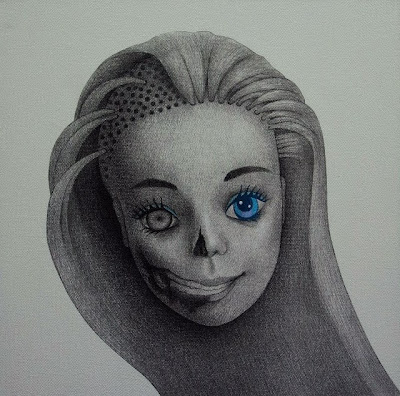 |
| my drawing: from pencils to inks / mi dibujo: del lápiz a la tinta |
So I am an expert of that era, not because I was born in a different date but because of, how should we put it, geographical accidents. It was like I had no other choice. So it was quite a shock, and a challenge, trying to catch up with years of issues that I had missed. It was so strange to get an issue of Superman printed in 1993 that my aunt would send me from the US and read it and compare it to the last issue I had read, in Spanish, with a cover date of 1987 or 1988.
And the same applies to 2000 AD, I think I have read nothing published in the nineties, but I have a lot of issues from the early eighties and late seventies, and that’s what I like and reread the most, I just love it.
So you could say I’m an honorary 80s boy, and I’ll always be. Anyway, I would love to read even older stuff, but since it is not a priority I keep saying I’ll buy Marvel Masterworks or DC Archives next time I have fifty bucks to spare, and of course there is never such a time.
I love to get a USPS box (or a flat rate envelope) and just spend the entire day reading it all. I can’t keep comic books "in storage" and read them after a week, I have to read them instantly, and only if I have something very important to do I might postpone the task.
Evidently I don’t think we can find logic in such arbitrary situations as reading comic books. Anyway, I must say I have some sort of "order" when I get new comics. I used to start reading the ones I was less interested in (or the ones that were most likely to disappoint me).
Nowadays I go with the art. I've found that daylight helps me enjoy the art a whole lot more, so now I choose the comics that have the best art and I give them priority. After sunset, I just turn on the lights and I read the ones that have bad art. Even so, sometimes it is really hard to make the decision, but you can’t read them all at the same time, can you?
 |
| I love to cook, this sure was a fun lunch / me encanta cocinar, y este almuerzo salió muy bien |
________________________________________________________________________________________________
 |
| El Museo Pedro de Osma fue el escenario ideal para brindar con un buen pisco |
La celebración empezó con un brindis de pisco puro, un Italia aromático que se dejaba tomar muy bien. Luego hubo pisco sour, como debe ser. Y yo aproveché que muchos de los invitados, quizás cohibidos por la presencia de un trago helado en un día ya de por sí bastante gélido, se sirvieron apenas una vez, para servirme una y otra (y otra) vez. Por supuesto, todos disfrutamos de los bocaditos y los postrecitos que nos ofrecieron los atentísimos y jovencísimos mozos de Cenfotur.
 |
| Además de pisco, también hubo bocaditos y mini-postres |
Hacía tiempo que no cocinaba, así que hace poco me animé. La invitada de honor, por supuesto, fue mi amiga María Fe. Entrada: pimientos rellenos de queso mozzarella con migajas de pan tostado. Plato de fondo: tortellinis con salsa blanca y lomito de cerdo al horno con champiñones y culantro. Postre: una exquisitez de coco y chocolate de Dolce Capriccio, cortesía de María Fe (yo debo haberme comido como dos o tres porciones… ¡rompí la dieta!). Maridaje: Una botella de Arium Albali Crianza 2005, un vino español que compré hace 8 años y que tenía reservado para una ocasión especial como esta. Todos disfrutamos de un ameno almuerzo y, qué duda cabe, pronto habrá otro.





















